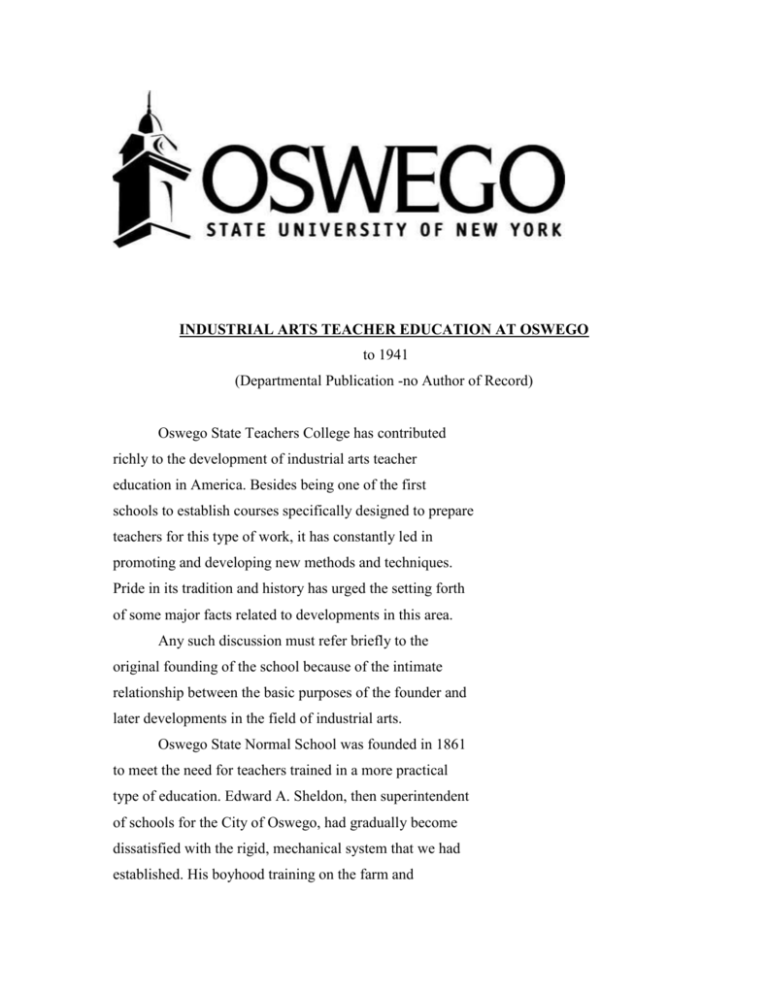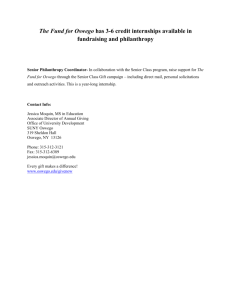INDUSTRIAL ARTS TEACHER EDUCATION AT OSWEGO
advertisement

INDUSTRIAL ARTS TEACHER EDUCATION AT OSWEGO to 1941 (Departmental Publication -no Author of Record) Oswego State Teachers College has contributed richly to the development of industrial arts teacher education in America. Besides being one of the first schools to establish courses specifically designed to prepare teachers for this type of work, it has constantly led in promoting and developing new methods and techniques. Pride in its tradition and history has urged the setting forth of some major facts related to developments in this area. Any such discussion must refer briefly to the original founding of the school because of the intimate relationship between the basic purposes of the founder and later developments in the field of industrial arts. Oswego State Normal School was founded in 1861 to meet the need for teachers trained in a more practical type of education. Edward A. Sheldon, then superintendent of schools for the City of Oswego, had gradually become dissatisfied with the rigid, mechanical system that we had established. His boyhood training on the farm and 2 workshop convinced him that in the practical materials and activities of such occupations there was much education value. Accordingly, he looked about for a more realistic approach to learning. He discovered what he felt to be the answer to this problem while on a visit to Toronto, Ontario in 1859. Here he found an exhibit of products of the Home and Colonial Training Institute of London, in the form of charts, books, pictures, and collection of objects. He purchased three hundred dollars worth of these materials and upon his return to Oswego lost no time in preparing a new course of study into which he incorporated the study of objects, and also the use of objects in the teaching of number, language, geography, and other subjects. The results were convinced both teachers and the superintendent that adoption into schools of the country was of the utmost importance. Preliminary experiences, however, emphasized the need for a more thorough training of teachers in the methods of using objects. Accordingly, Miss M. E. M. Jones was brought from England to take charge of the training school for teachers. She arrived May 1, 1861. With the coming of Miss Jones, the Oswego Normal School took form, and dates its history from time forward. She remained in Oswego for a little over a year and after her return to England those whom she had trained carried on the work. Before leaving she recommended Dr. Hermann Krusi, then a teacher and lecturer at Lancaster Normal School in Massachusetts. He accepted the position and thus, the son of a man who had worked with Pestalozzi (known as the father of manual training) became the head of the training class at Oswego. 3 At this time (1863) Mr. Victor M. Rice, then State Superintendent of Public Instruction became interested in the work at Oswego and succeeded in getting a sum of three thousand dollars per year for the support of the project. Following this in 1866 the school became one of the regular state normal schools, by legislative enactment. The normal school grew in importance and influence from this time forward. Teachers came from all parts of the United States and from foreign countries, and the graduates were eagerly sought by schools far and near. During the period from 1866 to 1886 the stress was placed upon object teaching as an end in itself, and as an aid to sense perception and a cultivation of the faculties. It was inevitable, however, that many of the values that we now claim for the practical arts should come from teaching. Note for example some of the principles laid down by Dr. Sheldon as a guide for teaching: 1. Activity is the law of childhood. Accustom the child to do – educate the hand 2. Begin with the senses and never tell a child what he can discover for himself Dr. Sheldon was a firm believer in the use of actual objects in teaching. Herman Krusi writes: “Object lessons as introduced into England by Miss Mayo, and into this country by Mr. Sheldon are…illustrated by objects or pictures placed before the children to be seen and handled, thus stimulating observation and cultivating perception directly.” Thus the children learned of size, weight, form and material. A glance through Dr. Sheldon’s books on Object Teaching shows us such headings as: Color, Form, 4 Size, Weight, Wood, Metals, Manufactured Articles, etc. The material covered by these headings includes much of the information that we claim to be giving in industrial arts courses of today. Such terms as “Consumer Knowledges”, “Aesthetic Appreciation”, and “Technical Knowledges” find a constant echo in these and other works on the subject, which were written during these years. As much practical work as possible was afforded along the lines of measuring in connection with size studies, while each class in form of drawing made use of modeling as a regular part of the work. It can scarcely be a matter of surprise, therefore, that Dr. Sheldon watched with much interest the development of industrial arts (then known as manual training) in the schools of the country. To him it must have seemed but a logical extension of the objective teaching for which he stood. At the beginning of the school year of 1886-87 he announced his intention of starting industrial arts at Oswego State Normal School. Accordingly, a shop was fitted up and placed in charge of the head janitor, Mr. F.H. Cyrenius. Students came to his shop at their Convenience to develop skills and to make simple apparatus for use in their demonstration teaching. Concerning this first venture and some of the difficulties that beset it Dr. Richard K. Piez writes: “The shop was arranged and equipped with an assortment of tools. Students were interested. Members of the faculty approved and gave their moral support and cooperation. All kinds of useful things were thought of. Some of them were made. 5 All of those made served a useful purpose. But for some reason the venture did not succeed. Many students could not avail themselves of the shop and it’s equipment. There was no time set apart for this additional work and many students could not add work to their heavy load. It was soon discovered that mere desire to construct a devise did not compensate for a lack of skill. Tools were soon dulled and unusable. Only an occasional student could sharpen a chisel or plane-bit. Auger and gimlet bits lost their keen edges. The extra demand on an already overworked janitor became too great. Some faculty members became apathetic. Nevertheless, Dr. Sheldon did not abandon this project.” In sprite of discouragements, Dr. Sheldon persisted in his belief in manual training as a corollary of objective teaching. He perceived, however, that a specially trained and experienced teacher was required. Accordingly, in 1893 he succeeded in securing the services of Richard K. Piez to reorganize and teach this new work. He likewise secured an appropriation of $6000 for fitting up a suitable room and equipping it with the necessary tools. From this time forward there was a continuous and rapid growth in the development of the manual training department. This will be discussed in more detail in a later part of this paper. Legalizing The Training of Manual Training Teachers at Oswego 6 It becomes necessary to report at this point a significant development that affected the development of industrial arts at Oswego. Although, as has already been pointed out, the first shop organization was not entirely successful it holds the distinction of being the first manual training course to be organized in a normal school or teacher training institution in the country. Up to that time none of the normal schools had introduced the subject and consequently such instruction had never been legalized. Fortunately there was on the local board of Oswego Normal School, the Honorable M.C. Coon who was also a member of the state Legislature. He assumed the responsibility for securing the necessary legislation to make the teaching of this subject legal, not only at Oswego but in the other normal schools of the state. Concerning this development, Dr. I.B. Poucher said: “I have already stated that the Oswego Normal and Training School was the first school in the country to establish a manual training course. In the year 1888, Hon. S.M. Coon, a member of the local board of the Owego Normal and Training school, and also of the Legislature, with the emphatic approval of the Honorable Andrew S. Draper, who was then State Superintendent of public Instruction, introduced a bill in the legislature, legalizing the teaching of manual training in normal schools of the state. The bill passed both houses of the legislature and received the signature of the Governor. Very soon thereafter, a manual training course was introduced by the local Board of this school with the hearty approval of the State Superintendent.” 7 Thus the groundwork was laid for future developments in the new field. It will be of interest to trace the growth from these early beginnings to the present time. Development of Manual Training From 1893 to 1911 It has been intimated that real success in manual training did not come at Oswego until a specially trained teacher in the person of Richard K. Pies was secured in 1893. Even then it was not immediate. Being a graduate of a technical school, Dr. Piez's first thoughts were concerned with the development of skills. He naturally followed the custom of the times in having the students make a series of joints and other jobs of an exercise nature. Dr. Sheldon instinctively sensed that this type of work did not attain the ends which he had in mind. Concerning the way in which Dr. Sheldon influenced a change in the nature of the methods used, Dr. Piez writes: "he (Dr. Sheldon) emphasized construction of useful things, the functional aims, as primary, and technical efficiency as a means rather than the end of manual training. This conception was entirely due to his intuitive grasp of the need of the teachersin-training during the period in which he lived. As I learned my lesson in pedagogy, the technique of woodworking became a means and not the end; the students made a series of objects that they could use in the schoolroom. Just a few of these deserve mention here. Of course, each one made his own bench hook. This gave practice in sawing a fairly 8 wide board and learning to keep the kerf true. Many had to repeat this model several times. When a satisfactory one had been made it became part of the students tool equipment. Each made a yardstick one inch square in cross-section and exactly one yard long. One face was divided into three feet that were painted alternately black and white. The other face was subdivided into inches, alternately black and white. By holding the stick obliquely before a class both feet and inches division could be seen simultaneously and their relative lengths compared. The fourth face had the inches subdivided into halves, quarters and eighths. The quick workers were permitted to make a meter stick for comparison. Another model was the blackboard ruler. This was a cooperative affair. One of the more skillful members of the class dressed a fourfoot strip, preferably 1 1/2" thick, to a suitable width and then glued strips of cherry on the edges. The piece was then resawed into thin strips and each student finished his own ruler. Some ambitious members of the class made a pair of blackboard compasses. Of course, there were in evidence, then as now, the usual array of knickknacks like, necktie holders, ash receivers, then named burnt match receivers by the abstemious, picture frames which sometimes received mirrors, foot stools, card tables with cabriole legs (wonderful accomplishment), tool chest which should have been dovetailed but were nailed for the same reason then as now, cedar chests, pant stretchers, coat hangers, anything 9 anyone could think of as useful and could be made with ordinary hand tools." This lengthy quotation is included to indicate an important development. Here for the first time one notes a breaking away from the traditional stereotyped joint and exercise method of teaching manual training. Much later all schools tended to follow the lead of Oswego and based their work on the making of useful and well-designed projects. The exact influence, which Oswego may have had in this development, is not apparent, but it is of interest to note that long before other schools had adopted this practice it was commonly used here. Not long after the first introduction of manual training at Oswego there appeared evidence of a desire to extend this work to the pupils in the school of practice. This was finally brought about and is described by Dr. Piez as follows: "In 1894 the Oswego Normal School equipped a commodius shop with twenty benches, a full complement of tools and all the accessory furniture. Boys from the upper grammar grades spent a full period, 40 minutes daily, in this shop. Three periods were devoted to woodwork and two to drawing (mostly mechanical). The manual training models were different from those made in the Normal Course. They required less material and less manipulatory skill. Work in the shops was popular with the boys. It probably would have been more so if the attainment of skill had been more subordinated to the construction of useful things. 10 Many of the projects were useful or nearly so. The problems of designing models were little different in those days from what they are now. Normal School students taught the boys in these manual training classes. These individuals had all been trained in the manual training classes and had shown their proficiency in the various tool operations. Gradually an unforeseen development began to be evident. These students were being sought upon graduation by employers to teach manual training in public schools. Since there had been no attempt to prepare them to teach this subject, the fact that they were unusually successful came as a decided surprise. Thus, beginning about 1895 graduates from Oswego began to take manual training teaching positions not only in New York State but also throughout the nation. Just as Oswego had been famous as a center for the training of teachers in the technique of object teaching, it now became noted as a source of well prepared manual training instructors." Industrial Arts from 1902 to 1911 A new period in the development of the Industrial Arts Department came with the appointment in 1902 of Joseph C. Park to teach science and manual training. By this time it had become apparent that there was a real need for teachers in this field, so when Dr. Piez was called to take over other responsibilities within the school, Dr. Park 11 was placed in change of this program. The following year (1903) he was relieved of his science teaching so that he could give full time to the teaching of manual training and supervision of this work in the campus school. He organized and administered courses in manual training I, II, and III totaling 300 hours and drawing I, II, and III covering 300 hours, making a total of 600 hours. Students who completed this requirement in addition to the regular normal school course were given a special drawing and industrial arts certificate in addition to the regular diploma. From 1902 until 1910 Dr. Park did all of the teaching in the Industrial Arts Department with the help of student assistants. These assistants were chosen with care on the basis of their proven ability. Many of them later developed and directed outstandingly successful industrial arts departments in all parts of the United States while others became administrators. Mr. Orla A. Barton, who was student assistant in 1902, later became county superintendent of school at Valley City, North Dakota. Mr. Ernest J. Lonis, who was student assistant in 1903, later served with distinction in the New York State Legislature and is a leader in the State Grange movement. Mr. T. W. Breckheimer, who was also student assistant in 1903, later became head of industrial work for the high schools of Minneapolis, Minn. These examples were cited to indicate that the graduates of this period were almost without exception, highly successful in their chosen work. Industrial Arts from 1911 to 1921 12 It was not until 1911 that a special program and curriculum were provided for teachers of industrial arts. This course was approved by the State Education Department, May 2, 1911 and went into effect in September of the same year. It provided a full two years of work in the field of industrial arts. A total of 800 hours were devoted to professional subjects and practice teaching, 550 to liberal-cultural courses, and 900 to shop work. During the period in which this program was in operation, which was until 1921, the Department of Industrial Arts underwent its greatest expansion. In 1911 there was only one teacher (Arthur L. Perry) besides Dr. Park. The next year Fred L. Griffiths was engaged to teach woodworking and Ralph A. Loomis to instruct in printing. In 1916 a machine shop instructor was added to the staff and the next year an instructor in education. The effect of the war was evident in 1918 when instructors in plumbing, concrete, and auto mechanics were represented. J. D. Rudolph replaced Mr. Loomis as instructor of printing. At this time a special departmental stenographer, Miss Lillian House, was engaged. In 1920 Wadsor M. Scoville was engaged as the first teacher of drawing, and Richard D. Whitney as the first instructor in electricity. The following year Harry M. Karcher replaced Mr. Whitney in charge of electricity. During this period, the department grew from one shop and a drawing room to five shops and drawing (concrete, plumbing, and auto mechanics having been discontinued at the end of the war), and from two teachers to six. Two hundred and eight industrial arts graduates left the school during this time. Most of them are 13 still teaching and include many of the outstanding leaders in the field. Industrial Arts from 1921 to 1934 The story of the Industrial Arts Department at Oswego, since 1921, has been one of rather steady and consistent growth and progress. A new curriculum in 1921 brought the program in keeping with newer rends while public interest in industrial arts increased the demand for teachers. In 1930 the two-year course was abolished and a three-year curriculum, providing time for a more adequate preparation, was substituted. He need for more suitable quarters than the basement of the main building became apparent at about this time. Accordingly, a movement was started to obtain an appropriation for a new building. Through the efforts of Dr. James G. Riggs, who was then principal, Dr. Park, as well as numerous alumni and friends, and especially members of the State Education Department, the appropriation was passed by the Legislature and approved by Governor Franklin D. Roosevelt in 1930. Governor Roosevelt laid the corner stone for the building on August 28, 1930 and ground was broken on April 2, 1931. Formal dedication was held on June 16, 1932 with Dr. Frank P. Graves, Commissioner of Education as the principal speaker. Occupation of the new facilities began in the fall of 1932. Much careful and thoughtful planning went into the design of this new building and the result was that Oswego Secured for its industrial arts division a structure which even today is considered an example of what a modern 14 building for this type of work should be. The first floor provides shop facilities for woodworking with separate bench, mill, and finishing rooms, metalworking, and transportation. A classroom for related shop theory is also located on this floor adjacent to the shops. The second floor houses the administrative offices, the printing shop, the general shop as well as the library and classrooms. On the third floor one finds facilities for drawing and photography, chemistry and physics, the electric shop, and an attractive lecture room. All shops and laboratories are fully equipped with the most modern tools and machines. Leaders in industrial arts education from all parts of the country, when visiting the building, have pronounced it one of the outstanding examples of fine school planing in the country. The Four-Year Course Mention has been made concerning the increase in time devoted to industrial arts work from a mere 600 clock hours added to the regular normal school course in 1902 to the entire three year course in 1930. It was soon recognized that even this amount of time was not sufficient to do a complete job of training. An important reason for this related to changing a concept of the nature and purposes of industrial arts. For several years there had been a growing interest in the general shop idea. This had been recognized at Oswego in 1929 by the employment of Gene Essex to teach such a course on a college level. Even before this a theory course concerned with general shop objectives and methods was being given. The whole general shop idea emphasized the need for additional time in the training 15 program. No longer was it feasible to train an individual to teach woodworking or machine shop or any of the other specialized fields. It now became necessary for every graduate to be proficient in at least the basic processes of a wide variety of areas. This situation was recognized in 1934 by extending the training period to four years. The Struggle for the Degree The extension of the industrial arts course brought with it a vexing problem. Buffalo Normal School had started the training of industrial arts teachers in 1919 and had been made a State College in 1929(?). When the fouryear course for industrial arts teachers was approved, therefore, it was possible to grant degrees to those who completed this program at Buffalo but not at Oswego. This naturally placed Oswego at a disadvantage as regarded the recruiting and holding of students. There was also a feeling on the part of administration, faculty, and students that a four-year program of study should be recognized upon its successful completion by an appropriate degree. A movement was immediately started to secure the degree granting privilege for Oswego. The problem was complicated by the fact that other normal schools had similar specialized departments that were equally anxious to receive degrees. Faculty, students, alumni, and friends pressed the campaign however, and at the convocation of the Board of Regents of the University of the State of New York in October 1939, the announcement was made that the degree granting privilege had been extended to al of the special departments of the State Normal Schools. The first 16 class to receive such degrees was that of June 1940. In 1941 the general elementary programs were extended to four years and by legislative enactment, all of the State normal Schools became Teachers Colleges. The granting of the degree for industrial arts and other special subjects came almost coincidentally with the retirement of Dr. Joseph C. Park as director of the industrial arts division. For more than thirty-seven years he had guided the progress of an ever growing and expanding program. His boundless enthusiasm and untiring work were in no small measure responsible for the success of the industrial arts program that this paper has described. With the attainment of college status and the privilege of granting the degree, Oswego State teachers College entered upon a new era - new in terms of curricula and opportunities service. It is well that the description of further developments be at a later date when time has made possible an accurate evaluation of results and trends. Summary of Achievements in Industrial Arts at Oswego A study of the record reveals that Oswego has made both substantial and worthy contributions to the development of industrial arts teacher education. A summary of important features includes the following: 1. The foundations for industrial arts teacher education were firmly laid in a program of Pestalozzian object teaching as developed by Dr. Edward A. Sheldon. 17 2. Oswego seems to have been the first teacher training institution to establish a program of work in manual training. 3. Through the efforts of Oswego the training of teachers in the field of manual training was first legalized. 4. The substitution of usable projects for meaningless excises was an early development at Oswego. 5. Through a period of several decades Oswego has maintained a position of leadership in the preparation of industrial arts teachers. (end – Keyboarded by Greg Garrison, 3/2003)









